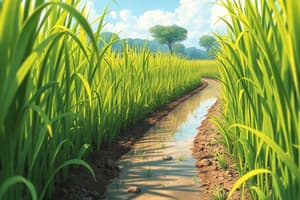Podcast
Questions and Answers
What is the primary difference between organic and inorganic fertilizers?
What is the primary difference between organic and inorganic fertilizers?
- Speed of nutrient release (correct)
- Environmental impact
- Type of nutrient provided
- Source of production
Crop rotation is a method of biological control.
Crop rotation is a method of biological control.
False (B)
What is the primary goal of integrated pest management?
What is the primary goal of integrated pest management?
To protect crops from damage caused by insects, diseases, and weeds
Soil ___________ sets the foundation for a successful crop.
Soil ___________ sets the foundation for a successful crop.
What type of irrigation system distributes water over the soil surface through gravity or pumps?
What type of irrigation system distributes water over the soil surface through gravity or pumps?
Foliar application is a method of applying fertilizers to the soil surface.
Foliar application is a method of applying fertilizers to the soil surface.
Match the following fertilizer application methods with their descriptions:
Match the following fertilizer application methods with their descriptions:
What is the first step in soil preparation?
What is the first step in soil preparation?
What is the primary importance of pest management?
What is the primary importance of pest management?
Crop rotation is a method of chemical control.
Crop rotation is a method of chemical control.
Flashcards are hidden until you start studying
Study Notes
Fertilizer Application
- Importance: Fertilizers provide essential nutrients for plant growth, improving crop yields and quality.
- Types:
- Organic fertilizers: derived from natural sources (e.g., animal waste, compost), release nutrients slowly.
- Inorganic fertilizers: manufactured from mineral sources (e.g., ammonium nitrate), release nutrients quickly.
- Application methods:
- Broadcasting: spreading fertilizers evenly over the soil surface.
- Banding: applying fertilizers in a narrow band near plant roots.
- Foliar application: spraying fertilizers directly on plant leaves.
Pest Management
- Importance: Pest management protects crops from damage caused by insects, diseases, and weeds, ensuring optimal yields and quality.
- Integrated Pest Management (IPM) strategies:
- Crop rotation and planning
- Biological control (e.g., introducing beneficial insects)
- Cultural control (e.g., adjusting irrigation and pruning)
- Chemical control (e.g., pesticides)
- Monitoring and surveillance: regular inspections to detect pest infestations early.
Soil Preparation
- Importance: Soil preparation sets the foundation for a successful crop, influencing soil structure, fertility, and water-holding capacity.
- Steps:
- Soil testing: analyzing soil pH, nutrient levels, and contaminants.
- Soil tillage: loosening and aerating soil to improve structure and reduce compaction.
- Soil amendment: adding organic matter (e.g., compost) or inorganic materials (e.g., lime) to adjust pH and nutrient levels.
- Soil leveling: creating a uniform soil surface for even water distribution and sunlight penetration.
Irrigation Systems
- Importance: Irrigation provides crops with the necessary water, especially in areas with limited rainfall.
- Types:
- Surface irrigation: water is distributed over the soil surface through gravity or pumps.
- Sprinkler irrigation: water is sprayed over the soil surface using sprinkler heads.
- Drip irrigation: water is delivered directly to plant roots through tubes and emitters.
- Irrigation scheduling: planning and managing irrigation events to minimize water waste and optimize crop water use.
Crop Rotation
- Importance: Crop rotation improves soil fertility, reduces pests and diseases, and promotes biodiversity.
- Principles:
- Crop diversity: rotating different crop species to break disease and pest cycles.
- Soil rest: allowing soil to rest and recover between crop cycles.
- Nutrient management: rotating crops with different nutrient requirements to maintain soil balance.
- Benefits:
- Improved soil health and structure
- Increased crop yields and quality
- Reduced chemical fertilizer and pesticide use
Fertilizer Application
- Fertilizers provide essential plant nutrients, enhancing crop yields and quality.
- Organic fertilizers derive from natural sources, releasing nutrients slowly.
- Inorganic fertilizers are manufactured from mineral sources, releasing nutrients quickly.
- Broadcasting involves spreading fertilizers evenly over the soil surface.
- Banding applies fertilizers in a narrow band near plant roots.
- Foliar application involves spraying fertilizers directly on plant leaves.
Pest Management
- Pest management protects crops from insects, diseases, and weeds, ensuring optimal yields and quality.
- Integrated Pest Management (IPM) strategies include crop rotation, biological control, cultural control, and chemical control.
- Crop rotation and planning help prevent pest build-up.
- Biological control introduces beneficial insects to combat pests.
- Cultural control adjusts irrigation and pruning to prevent pest infestations.
- Chemical control uses pesticides as a last resort.
- Regular monitoring and surveillance enable early detection of pest infestations.
Soil Preparation
- Soil preparation influences soil structure, fertility, and water-holding capacity, setting the foundation for a successful crop.
- Soil testing analyzes soil pH, nutrient levels, and contaminants.
- Soil tillage loosens and aerates soil, improving structure and reducing compaction.
- Soil amendment adds organic matter or inorganic materials to adjust pH and nutrient levels.
- Soil leveling creates a uniform soil surface for even water distribution and sunlight penetration.
Irrigation Systems
- Irrigation provides crops with necessary water, especially in areas with limited rainfall.
- Surface irrigation distributes water over the soil surface through gravity or pumps.
- Sprinkler irrigation sprays water over the soil surface using sprinkler heads.
- Drip irrigation delivers water directly to plant roots through tubes and emitters.
- Irrigation scheduling plans and manages irrigation events to minimize water waste and optimize crop water use.
Crop Rotation
- Crop rotation improves soil fertility, reduces pests and diseases, and promotes biodiversity.
- Crop diversity rotates different crop species to break disease and pest cycles.
- Soil rest allows soil to recover between crop cycles.
- Nutrient management rotates crops with different nutrient requirements to maintain soil balance.
- Crop rotation benefits include improved soil health and structure, increased crop yields and quality, and reduced chemical fertilizer and pesticide use.
Studying That Suits You
Use AI to generate personalized quizzes and flashcards to suit your learning preferences.




